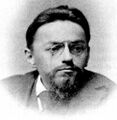Template:Selected anniversaries/April 9: Difference between revisions
Jump to navigation
Jump to search
No edit summary |
No edit summary |
||
| (40 intermediate revisions by the same user not shown) | |||
| Line 1: | Line 1: | ||
<gallery> | <gallery> | ||
|| | File:Thomas Seebeck.jpg|link=Thomas Johann Seebeck (nonfiction)|1770: Physicist and academic [[Thomas Johann Seebeck (nonfiction)|Thomas Johann Seebeck]] born. Seebeck will discover the thermoelectric effect. | ||
|| | File:Edouard-Léon Scott de Martinville.jpg|link=Édouard-Léon Scott de Martinville (nonfiction)|1860: On his phonautograph machine, [[Édouard-Léon Scott de Martinville (nonfiction)|Édouard-Léon Scott de Martinville]] makes the oldest known recording of an audible human voice. A visual recording of audio data, it will first be played back in 2008. | ||
File:Charles Proteus Steinmetz.jpg|link=Charles Proteus Steinmetz (nonfiction)|1865: Mathematician and electrical engineer [[Charles Proteus Steinmetz (nonfiction)|Charles Proteus Steinmetz]] born. Steinmetz will foster the development of alternating current, formulating mathematical theories which will advance the expansion of the electric power industry in the United States. | |||
File:Charles Proteus Steinmetz.jpg|link=Charles Proteus Steinmetz (nonfiction)|1865: Mathematician and electrical engineer [[Charles Proteus Steinmetz (nonfiction)|Charles Proteus Steinmetz]] born. | |||
File:Skip Digits.jpg|link=Skip Digits|1978: Musician and alleged math criminal [[Skip Digits]] performs at the Kennedy Center for the Arts. | File:Skip Digits.jpg|link=Skip Digits|1978: Musician and alleged math criminal [[Skip Digits]] performs at the Kennedy Center for the Arts. | ||
</gallery> | </gallery> | ||
Latest revision as of 03:48, 9 April 2022
1770: Physicist and academic Thomas Johann Seebeck born. Seebeck will discover the thermoelectric effect.
1860: On his phonautograph machine, Édouard-Léon Scott de Martinville makes the oldest known recording of an audible human voice. A visual recording of audio data, it will first be played back in 2008.
1865: Mathematician and electrical engineer Charles Proteus Steinmetz born. Steinmetz will foster the development of alternating current, formulating mathematical theories which will advance the expansion of the electric power industry in the United States.
1978: Musician and alleged math criminal Skip Digits performs at the Kennedy Center for the Arts.



